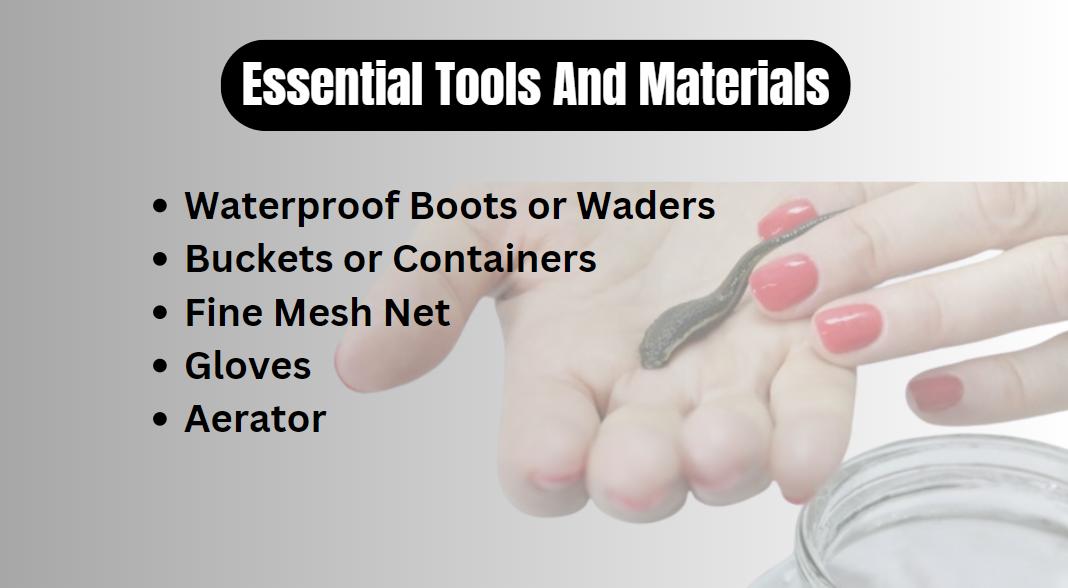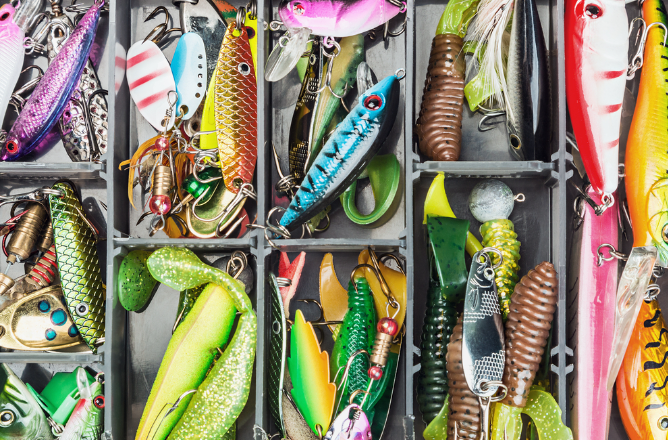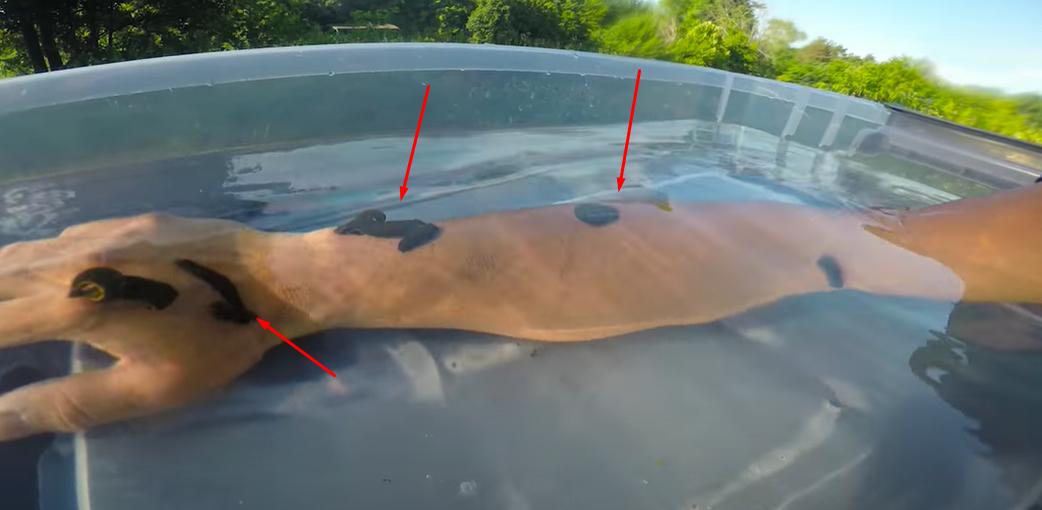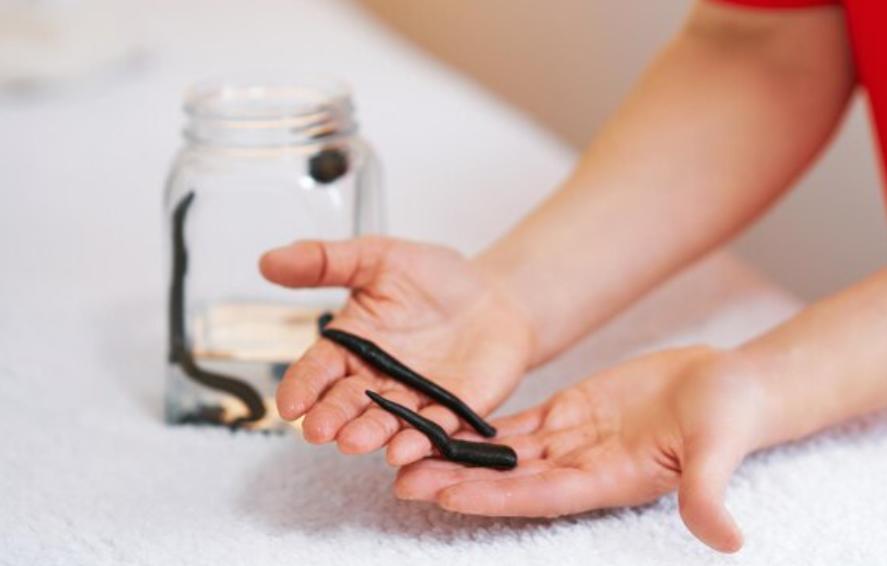To catch leeches for fishing bait, inspect muddy or sandy lake bottoms near the shore. Use a net or your hands to collect leeches from shallow water.
Anglers seeking an effective bait for their freshwater fishing excursions often turn to leeches for their enticing wriggle and widespread appeal to fish such as walleye and bass. Leeches are commonly found in many bodies of freshwater, which makes them both an affordable and efficient bait option.
Catching them requires patience, a keen eye, and a basic understanding of their habitats and behaviors. With simple gear like a bucket or flat pan and a piece of raw meat, anyone can attract these slimy creatures.
As bait, leeches are prized for their durability on the hook and their lively motion in the water, sparking the predatory instincts of many game fish. Enthusiasts favor early morning or dusk for catching leeches, as these are periods of peak activity for these wriggly bait favorites. How to Catch Leeches for Fishing Bait?

Collecting Equipment And Preparation
Commencing on the quest to gather leeches for fishing bait begins with the right preparation. Engage in this activity armed with the correct knowledge and tools for effective and ethical harvesting. Grasping the essentials can transform an otherwise daunting task into a rewarding experience. Prepare to Plunge into natural habitats with confidence as you Commence on your leech-collecting adventure!
Essential Tools And Materials

- Waterproof Boots or Waders: Protect yourself from the wet environment.
- Buckets or Containers: Store your catch; preferably with a secure lid.
- Fine Mesh Net: Skim through vegetation without harming the leeches.
- Gloves: Maintain a good grip and keep your hands protected.
- Aerator: Keep captured leeches oxygenated for prolonged vitality.
Rig up these items before venturing out. Purposeful preparation ensures a successful leech-gathering session, ultimately leading to a fruitful fishing expedition.
Finding The Right Location
For the successful capture of leeches to be used as fishing bait, pinpointing the perfect habitat is critical. High-population leech zones often share common characteristics, making some areas much more promising than others. By concentrating your efforts in these leech-favorable environments, your bait collection endeavors will yield better results, ensuring that you’re well-prepared for your next fishing trip.
Identifying Leech-prone Environments
Leeches thrive in calm, shallow waters where aquatic vegetation is abundant. Look for:
- Stagnant or slow-moving water bodies – Ponds, lakes, and slow-flowing streams with muddy bottoms provide ideal conditions.
- Rich organic matter – Decomposing leaves and wood create a nutrient-rich environment that leeches favor.
- Presence of wildlife – Areas frequently visited by birds and mammals can be hotspots, as leeches often attach to these hosts for transportation and sustenance.
Tips For Locating Leeches
- Search during the cooler hours of early morning or late afternoon, when leeches are more active.
- Inspect the water’s edge and submerged objects where leeches might be clinging or moving slowly.
- Use a fine-mesh net or bait trap to gently comb through weedy areas, increasing your chances of collection.
By employing these targeted techniques, anglers can optimize their leech-hunting expeditions, making sure they secure the most effective live bait for an impressive fishing experience.
Effective Leech Catching Techniques
Gearing up for a successful fishing trip involves securing the right bait, and leeches are prime choices for freshwater angling. Rich in protein and wiggly motion, they attract a wide array of fish. Finding effective ways to gather these bait-buddy gems improves your fishing repertoire. Below are tried-and-true methods for collecting leeches.

Hands-on Collection Methods
Use bullets for method steps
- Scout for leech habitat—look for calm, vegetative waters.
- Dress appropriately with protective gloves and perhaps waterproof attire.
- Search by slowly sweeping your hands through mud or debris.
- Store leeches in containers with a secure lid and fresh water.
Implementing Natural Baits

Use an ordered list to enumerate steps
- Choose your bait—dead fish, liver, or raw meat work well.
- Enclose bait in a mesh or perforated container to allow scent dispersion.
- Submerge bait in shallow waters, weighing it down with stones.
- Return to check the trap periodically and collect your bait.
Using Commercial Traps
For those looking to simplify the process and increase efficiency, commercial leech traps are an ideal solution. These devices are designed with entry points that are easy for leeches to navigate but challenging to escape. To use them:
Use bullet points with a table for different trap types
- Place your bait inside the trap and seal it.
- Submerge the trap in leech-populated waters.
- Allow the bait to attract the leeches over a few hours or overnight.
Table of common trap types and their characteristics
| Trap Type | Features | Benefits |
|---|---|---|
| Cone or Funnel Trap | Tapered entryway with a larger opening | Easy to set and retrieve |
| Cylinder Trap | Multiple entry points | Ideal for trapping large numbers of leeches |
| Box Trap | Flat, rectangular design | Great for shallow waters |
With proper placement and appetizing bait, these traps are highly effective. The best choice largely depends on the specific leech species you’re targeting and the conditions of your local waters.
Safety Precautions And Handling
Before you can boast about a bountiful fishing trip, you must secure your wriggling, squirming leech bait. Leech gathering, while a somewhat gruesome task, is crucial for successful angling. Prioritize safety measures during the collection process to avoid undesirable encounters. A keen understanding of safe handling practices will ensure that your bait acquisition is not only effective but also free from unnecessary complications.
Dealing With Leech Bites

- Do not pull leeches off abruptly, as this can cause the leech’s mouthparts to remain in the wound.
- Slide a fingernail or flat object under the sucker of the leech at the site of attachment and push it sideways to remove the leech.
- Once removed, clean the area with soap and water and apply an antiseptic cream to prevent infection.
- Observe the bite for any signs of infection or unusual reactions and seek medical attention if necessary.
Proper Storage And Transport
Ensuring the vitality of your leeches from capture to hook maximizes bait effectiveness. Follow these steps for proper storage and transport:
- Contain leeches in breathable containers like ventilated jars or leech locker containers.
- Maintain cool temperatures, ideally between 40°F and 50°F, to keep leeches dormant yet healthy.
- Change their water every other day with dechlorinated water to keep it clean and well-oxygenated.
- Before transport, transfer leeches to a sturdy container with a tight lid to prevent escapees.
- Shield leeches from direct sunlight during travel to prevent overheating.
Utilizing Collected Leeches For Fishing

Find the efficient techniques to gather leeches, a sought-after bait among anglers, with our practical guide. Master the skill of harvesting these slippery critters to ensure your tackle box is never without this effective lure for your next fishing excursion.
Preparing Leeches As Fishing Bait
- Clean: Begin by rinsing your leeches in fresh water to remove any debris or sediment.
- Sort: Next, sort the leeches by size, keeping the larger, more active ones for larger fish.
- Condition: Store them briefly in a container with clean water and a handful of decomposing leaves to mimic their natural environment, which can invigorate them.
- Refrigerate: To slow down their metabolism and preserve freshness, leeches can be stored in the refrigerator in a container lined with damp paper towels.
Techniques For Baiting Hooks
Baiting hooks with leeches can be a delicate art. Here’s how to do it:
- Hook Placement: Insert the hook either through the sucker or the tail—piercing through the sucker might make leeches more lively, enticing fish with their movement.
- Avoid Damage: Be gentle to prevent excess damage to the leech, which could reduce its effectiveness.
- Adjust Position: Depending on the fish species you’re targeting and water conditions, experiment with the hook placement to achieve many swimming actions.
| Fish Species | Recommended Technique |
|---|---|
| Walleye | Drag or jig near the bottom |
| Bass | Use under a bobber or free-line |
| Panfish | Small segments on tiny hooks |
Maximizing Fishing Success
Find the techniques for harvesting leeches, the cunning bait that can significantly improve your fishing outcomes. Mastering leech collection provides anglers with a fresh, lively lure that’s irresistible to many fish species.
Understanding Leech Behavior In Water
- Leeches prefer darker areas during the day.
- They are attracted to organic matter and decaying vegetation.
- Movement and vibrations can draw them out.
Tips For Conserving Bait And Attracting Fish
Savvy anglers know that handling bait correctly is just as important as capturing it. To ensure your leeches stay lively and increase your chances of a catch, consider the following:
- Keep leeches cool: Store them in a container out of direct sunlight, possibly with a cool pack, to keep them fresh.
- Aerate the water: Use a simple aerator to provide oxygen, mimicking their natural habitat and keeping them active.
- Change water regularly: Fresh, chlorine-free water prevents the build-up of harmful substances.
- Hook leeches properly: Thread them to ensure free movement; the more they squirm, the better they attract fish.
- Mimic natural behavior: When fishing, make your leech swim and dance with small, slow movements to replicate their behavior in the wild.
Frequently Asked Questions On How To Catch Leeches For Fishing Bait
How Do You Catch Leeches For Bait?
To reel in leeches for your fishing adventure, setting the perfect trap is key. But first, let’s talk bait. What’s the best bait for a leech trap? Natural options like raw chicken liver or fish guts work wonders. Settle on a bait that emits a scent – leeches have a keen sense of smell.
Construct a homemade leech trap using simple materials like plastic bottles or PVC pipes. Drill holes into the container and insert the bait securely. Place it in a leech-populated area, such as ponds or slow-moving streams.
When to check your trap? Timing is crucial. Early mornings or late afternoons are prime. They’re nocturnal creatures, so they’re most active during these periods.
Remember, patience pays off. Upon checking, remove the trap carefully, avoiding sudden movements. Voila! You’ve caught your leeches for bait.
Whether you’re a seasoned angler or a beginner, understanding how to catch leeches for bait opens up a world of fishing possibilities. Stay tuned for our Summation where we inquire deeper into the art of leech trapping!
What Is The Best Trap For Leeches?
The best trap for leeches is a simple baited container with small openings, like a perforated plastic bottle or jar.
Where Is The Best Place To Catch Leeches?
The best places to catch leeches are in shallow, still waters with abundant vegetation, such as ponds, swamps, and marshes. Look for areas with decaying logs and leaves.
How Do You Hook Leeches For Fishing?
Hook leeches for fishing by threading the hook through their sucker end. Ensure the leech can move naturally, attracting fish effectively. Avoid damaging the leech’s body for maximum liveliness.
Conclusion
Catching leeches for bait doesn’t have to be daunting. With the right techniques and some patience, you’ll have a bait bucket full of these wriggly critters. Remember, fresh leeches can make all the difference in your fishing success. So grab your bucket, head to the nearest water body, and start gathering your superior fishing allies today! Happy fishing!

